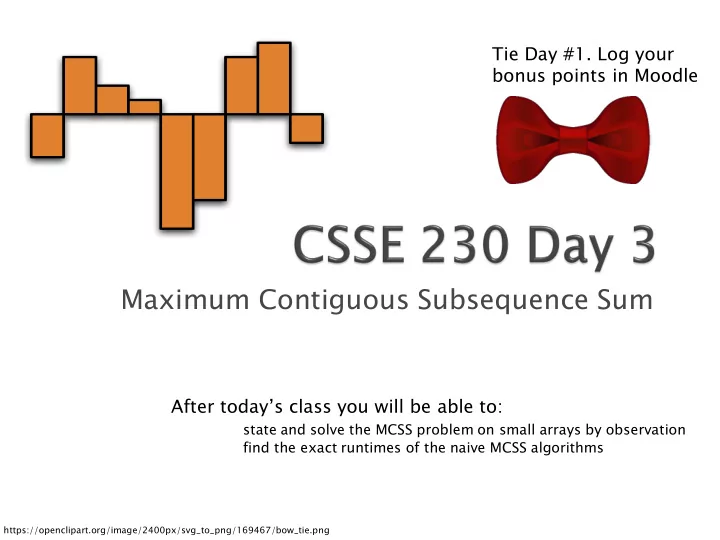

Tie Day #1. Log your bonus points in Moodle Maximum Contiguous Subsequence Sum After today’s class you will be able to: state and solve the MCSS problem on small arrays by observation find the exact runtimes of the naive MCSS algorithms https://openclipart.org/image/2400px/svg_to_png/169467/bow_tie.png
Consider the limit f ( n ) lim g ( n ) n What does it say about asymptotic relationship between f and g if this limit is… ◦ 0? ◦ finite and non-zero? ◦ infinite? Q12, day 2
1. n and n 2 2. log n and n (on these questions and solutions ONLY, let log n mean natural log) 3. n log n and n 2 4. log a n and log b n (a < b) 5. n a and a n (a > 1) 6. a n and b n (a < b) Recall l’Hôpital’s rule: under appropriate conditions, Q13-15
Q1 A deceptively deep problem with a surprising solution. {-3, 4, 2, 1, -8, -6, 4, 5, -2}
It’s interesting Analyzing the obvious solution is instructive We can make the program more efficient
Proble blem: Given a sequence of numbers, find the maximum sum of a contiguous subsequence. Consider der: ◦ What if all the numbers were positive? ◦ What if they all were negative? ◦ What if we left out “contiguous”?
Q2 Q2-4 Quiz questions: ◦ In {-2, 11, -4, 13, -5, 2}, S 2,4 = ? ◦ In {1, -3, 4, -2, -1, 6}, what is MCSS? ◦ If every element is negative, what’s the MCSS? 1-based indexing. We’ll use when analyzing b/c easier
Q5 Q5 ◦ Must be easy to explain ◦ Efficiency doesn’t matter. ◦ 3 minutes Examples to consider: ◦ {-3, 4, 2, 1, -8, -6, 4, 5, -2} ◦ {5, 6, -3, 2, 8, 4, -12, 7, 2}
Find d the sums ms of all subse bsequ quence ces i: beginni nning ng of Where subseque uenc nce will this algorithm j: end of subseque uenc nce spend the most k: steps throug ugh h time? each h element ent of subsequenc uence How many times (exactly, as a function of N = a.length) will that statement execute?
What statement is executed the most often? How many times? How many triples, (i,j,k) with 1≤i≤k≤j≤n ? Outer numbers could be 0 and n – 1, and we'd still get the same answer.
By hand Using Maple
Q6, Q7 How many triples, (i,j,k) with 1≤i≤k≤j≤n ? What is that as a summation? ◦ Can also just get from code Let’s solve it by hand to practice with sums
When it gets down to “just Algebra”, Maple is our friend
Computer Science is no more about computers than astronomy is about . Donald Knuth
Computer Science is no more about computers than astronomy is about telescopes. Donald Knuth
= 𝑜 + 2 𝑜(𝑜+1)(𝑜+2) Observe that , 3 6 from basic counting/probability The textbook makes use of this in a curious way to find the sum more easily. Fun, but not required for class.
We showed MCSS is O(n 3 ). ◦ Showing that a problem is O(g(n)) is relatively easy – just analyze a known algorithm. Is MCSS W (n 3 )? ◦ Showing that a problem is W (g(n)) is much tougher. How do you prove that it is impossible to solve a problem more quickly than you already can? ◦ Or maybe we can find a faster algorithm?
The performance is bad!
This is Θ (?)
Is MCSS W (n 2 )? ◦ Showing that a problem is W (g(n)) is much tougher. How do you prove that it is impossible to solve a problem more quickly than you already can? ◦ Can we find a yet faster algorithm?
Q8 Q8, Q9 Tune in next time for the exciting conclusion! http://www.etsu.edu/math/gardner/batman
Recommend
More recommend